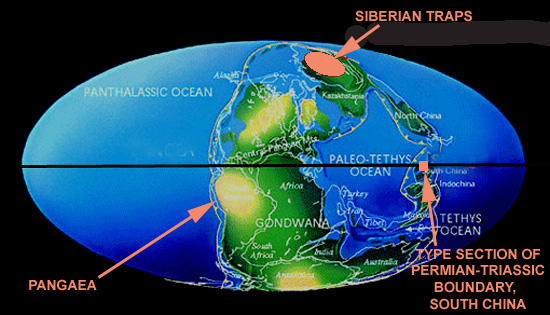
With more than 90% of all marine species and 75% of land species wiped out, the end Permian mass extinction was the worst biosphere crisis in the last 600 million years. The extinction was global in reach: almost all animals and plants in almost all environmental settings were affected. An idea of the severity can be visualised by considering that the time afterwards was marked by the beginning of a coal gap lasting for ten million years: coal-forming ecosystems - i.e. forests - simply did not exist for that time.
The onset of the mass extinction coincided with the main part of the eruption of the late Permian Siberian Traps Large Igneous Province (LIP), 251.9 million years ago (Ma). It contains what may be the largest known volume of terrestrial flood basalt in the world. Estimates vary but they start at volumes of at least 3 million cubic kilometres of igneous rocks that were erupted onto and intruded beneath the surface during the event. There are some much larger volume estimates that take into account "missing" erupted rocks since eroded away and the likely ratio of intruded to erupted rocks. Either way, as eruptive cycles go this was one of the biggest ever.
At the same time, there was a dramatic perturbation to the global carbon cycle, involving the injection of enough carbon dioxide to the atmosphere to triple the pre-existing levels and raise temperatures substantially. There were severe problems with other pollutants: acid rain, soil erosion, algal blooms and ocean acidification and anoxia all took a dramatic toll on life on land and in the seas.
That the Siberian Traps eruptions, the greatest of the Big Five mass-extinctions and carbon cycle havoc all happened in broadly the same geological timezone suggests they may not be unrelated. However, coincidence is not necessarily cause. For example, what if the extinction occurred a million years before the Traps were erupted?
To resolve such key questions we make use of high-resolution radiometric dating and biostratigraphy - the precise study of changes in the fossil record over a geologically short and age-constrained time-frame. This post takes a look at the latest advances in research concerning the extinction event and how it unfolded, and then goes on to see how it compares to what we are doing to the planet. It's not exactly good news.

Fig. 1 (above): Earth at the time of the end-Permian mass extinction, 252 million years ago. Re-annotated from Christopher Scotese' Palaeomap Project.
Fig. 2 (below): Modern-day Asia with the vicinity of the Siberian Traps (see fig. 3 for details) outlined in red. 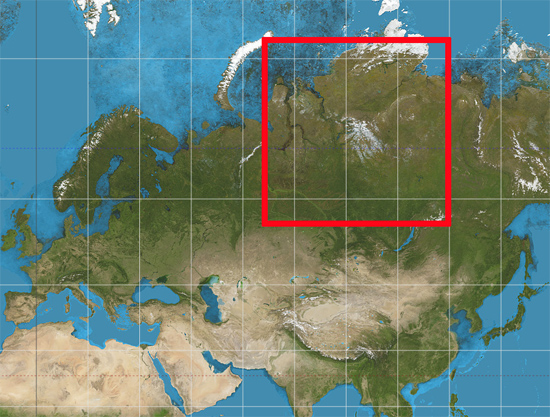
Getting the exact timing of the Siberian Traps and the mass extinction nailed has long been a major goal of the Earth Science community. In recent years, such age-constraint has materialised, since precise radiometric dating of rocks has come along in leaps and bounds. The sedimentary rocks in the type sections for the Permian-Triassic boundary, in China, have long been scrutinised in depth, their individual beds numbered, their sedimentary characteristics described and their micro and macrofossils catalogued layer upon layer, so that the precise point in the sequence where the extinction occurred has been well-defined.
Fortuitously, there are also beds containing volcanic ash within the critical Chinese sequence. These yield tiny crystals of the mineral zircon, which is zirconium silicate. Zircons may be dated using high-precision methods that exploit the radioactive decay of uranium (a trace element in zircons) to lead. The technique of U-Pb dating, as it is known, involves (in a nutshell) separating out the zircons from a sample of rock – a painstaking process – and through analysis, dating them. Then repeat with the ash-bed above, and the one above that, and so on. As a result of the dating, it is now thought that the onset of the main extinction was at 251.941 +/- 0.037 Ma and its duration was less than 61 +/- 48 thousand years.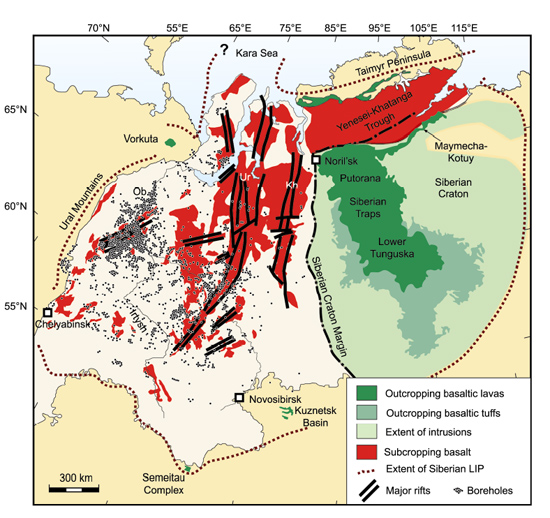
Fig. 3: Geology of the Siberian Traps LIP. The main outcrops of lavas, tuffs and intrusive rocks are shaded green. Basalt lavas that are known or suspected to be buried at depth are shown in red. The estimated limit of the Siberian Traps LIP is indicated by the dotted line. After Saunders & Reichow, 2009.
Zircons are rare in basaltic rocks such as those found in the Siberian Traps, but there are some rocks there from which they can be obtained. The overall subaerial sequence in the Traps (fig. 3) is an early pyroclastics formation – smashed rock and ash formed by explosive volcanic activity, overlain by up to four kilometres of basaltic lava flows. Between some of the lava flows there occur thin felsic tuffs, silica-rich rocks whose precursor was volcanic ash, which do contain zircons. Using new data based on those zircons, the eruption of the Siberian Traps LIP commenced with explosive magmatism and pyroclastic deposition between 255.21 +/- 0.37 Ma and 252.24 +/- 0.12 Ma. Eruption of lava-flows was from then on sustained until 251.904 +/- 0.061 Ma, giving a maximum period of 300,000 years or so for a large part of the lava production. A hiatus then followed for some half a million years before activity recommenced in some areas and kept going until 250.2 +/-0.3 Ma, into the earliest Triassic. It is clear that by the point of the onset of the mass-extinction, a huge quantity of products had been erupted.
So: we have the large part of a LIP eruption in the 300,000 year long lead-up to the extinction interval and over it, and we have the extinction itself. What other lines of evidence might connect the two things as being more than coincidental? Firstly, something dramatic happened to the global carbon cycle (the complex system by which carbon is exchanged between organisms, soils, rocks, rivers and oceans and the atmosphere) at precisely the same time. It became grossly overloaded.
Variations in the carbon cycle on Earth are recorded by changes in carbon isotope ratios through time. Carbon has two stable isotopes, carbon 12 and carbon 13, occurring in a ratio of about 99:1. They are partitioned in natural systems: plants, be they mighty trees or lowly green algae, preferentially use carbon 12 in photosynthesis. Things eat plants and thus the resulting isotope shift in favour of carbon 12 is spread up though the food chain. Where the plants and the remains of that food chain end up preserved in the geological record – for example as coal, limestone or other fossil material – they will carry that same, "light" carbon isotope ratio. If the coal is then burned, forming carbon dioxide, it will add that light carbon to the atmosphere and, in due course, to the oceans.
Now, the lead-up to the Permian-Triassic boundary (fig. 4) coincides with a major, negative carbon isotope excursion, lasting for over 500,000 years, of 4 parts per thousand (from +3 to a typical earliest Triassic value of −1‰), as measured in both marine carbonates and organic material. Superimposed on this negative trend there was, during the descent from positive to negative values, a much briefer even more negative spike (from +2 down to −4‰). The spike marked the onset of the extinction itself and, including its subsequent rebound, it had a duration of between 2,100 and 18,800 years. It is so distinctive that it serves as a marker-horizon all over the world, pinning down the start of the extinction-interval even in sedimentary rocks that are unfossiliferous.
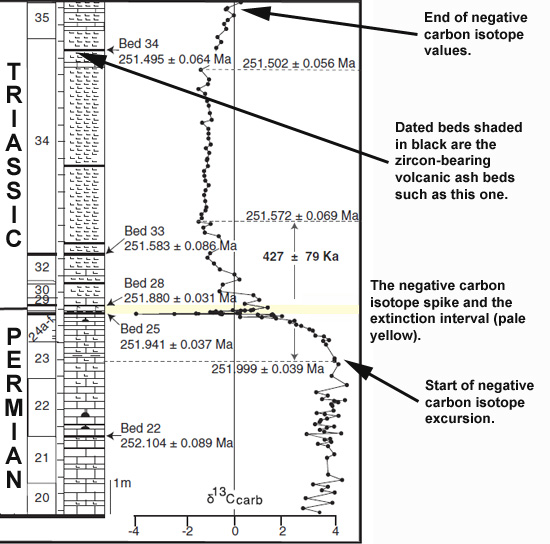
Fig. 4: the type section of the Permian-Triassic boundary in southern China, showing the dated ash-beds, the extinction interval and the carbon isotope record from the time including the dramatic, negative spike at the onset of the extinction. After Burgess et al, 2014.
To change, in its entirety, the isotopic ratio of the vast quantities of carbon dissolved in the world's oceans by this amount, requires a massive perturbation to an already-perturbed carbon cycle. It would need the injection, to the atmosphere, of a vast amount of isotopically light carbon. The changes in carbon dioxide levels at the time have been estimated using the stomatal leaf index in fossil plants and isotopic studies of fossilised soils. From around 2300ppm in the late Permian the levels jumped to as much as 7832+/-1676 ppm at the time of the extinction - a trebling. Where could that extra carbon dioxide have come from?
To begin with, it has been estimated that the entire Siberian Traps LIP eruptive cycle produced thirty thousand billion tonnes of carbon dioxide directly from magmatic outgassing. However, mantle-derived carbon dioxide is not that light, which makes it difficult to reconcile as the single source responsible for the isotope excursion. One suggested solution to that problem is that the recycling of subducted oceanic crust into the pre-eruption magma added a lot of lighter carbon to the mix. If that was the case then the eruptions could – perhaps - better account for the isotopic excursion.
Another quite credible solution involves the liberation of huge quantities of isotopically light carbon dioxide and methane as a consequence of the heating and combustion of coal and petroleum. Such gases are referred to in the literature as "thermogenic", meaning that they were produced by heating stuff. There's an awful lot of coal in the Middle Carboniferous to Lower Permian sedimentary rocks that underlie the Siberian Traps. Beneath that there exists an older Palaeozoic sequence of rocks that includes a great thickness of Cambrian evaporite beds (mostly rock-salt - sodium chloride and anhydrite - calcium sulphate) and associated significant concentrations of oil and gas. Deep pathways for both intruding and erupting magma would have passed up through the evaporites and coal deposits alike, baking them (liberating carbon-based gases) and also bringing coal mixed with magma up to the surface (where it would immediately combust - fig. 5). The explosive nature of such combustion has been calculated to be sufficient to push the eruption-plume up into the stratosphere. Evidence for coal combustion has been discovered in the form of particles closely resembling coal fly-ash in a Permian-Triassic boundary sequence in Arctic Canada. Back then the area was at a similar latitude to and downwind from Siberia, and although other workers have suggested the material could be char from wildfires, which may produce similar particles, comparison of the particles with those making up modern fly-ash shows that they are identical in structure.
Evidence for major gas release associated with the Siberian Traps LIP is present in the form of thousands of hydrothermal vents - deep-seated pipe-like pathways to the surface taken by superheated mineral and gas-rich water - developed in the rocks situated above sills and other intrusions. Some of them are actively mined for the minerals that they contain. Each vent represents a degassing location with surface expressions at the time of the activity in the form of geysers and fumaroles. Hydrocarbon gases such as methane and halogen-bearing compounds like methyl chloride would have been the main products: methane would of course oxidise quickly to carbon dioxide once reaching the atmosphere. It has been estimated that these processes could have added as much as 100,000 billion tonnes of carbon dioxide to the atmosphere.
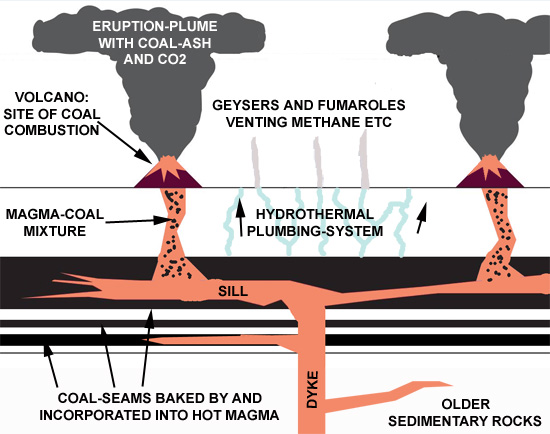
Fig. 5: Schematic showing the interaction of magma and coal seams in the Siberian Traps. Now multiply this in your minds eye by many times and you have what it was like there in the late Permian. After Ogden & Sleep, 2012.
Methane clathrate destabilisation has also been invoked, but with little real evidence in contrast to the volcanogenic and thermogenic sources outlined above: given that both of those scenarios are entirely plausible, it's probable that they both had a role to play. Now, just try to picture the scene at the height of these eruptions. Numerous volcanoes with lava fountains continuously on the go and great lava flows spilling out over the landscape for as far as the eye can see. Towering eruption-plumes of black sulphurous smoke, lightning-riven and merging into a hellish dark canopy stretching over the horizon. In between the volcanoes, bubbling, reeking fields of fumaroles, with clouds of steam and every now and then the whoosh as another explosive geyser shoots skywards, and another and another. Siberia at the height of the Traps eruption would have been like Mordor on steroids.
Unsurprisingly, a variety of kill-mechanisms have been proposed for the end-Permian mass extinction, mostly linked back in one form or another to the Siberian Traps. There is good evidence pointing to a rapid, dramatic increase in marine and terrestrial temperature. Decreases in the oxygen isotope ratios of shallow marine limestones indicate that seawater temperatures across the extinction interval rose by as much as 6–10°C. Studies of ancient soils occurring in terrestrial sedimentary rocks of the same age are consistent with this finding. Problems arising from repeated massive injections of carbon dioxide to the atmosphere would tend to persist over much longer timescales than those caused by other pollutants simply because of the long atmospheric residence time of carbon dioxide. With eruptions taking place even a century or so apart, CO2 levels would be recharged often enough to provide a net atmospheric gain on each occasion.
There is also evidence of severe disruption to ocean chemistry. The calcium isotope records of marine carbonate rocks and of calcium phosphate minerals that preserve conodonts (teeth-like microfossils) have recently been studied at one of the key sections in southern China. Both reveal a negative excursion over the extinction interval. Such parallel negative excursions in both carbonate rocks and conodont calcium phosphate cannot be accounted for by a change in carbonate mineralogy. However, they are consistent with a negative shift in the calcium isotope ratio of seawater, something best accounted for by ocean acidification.
Supporting that assertion is the fact that marine animals suffered significantly different levels of extinction which depended on two key things. These were firstly their requirements for carbonate ions in constructing their skeletons and secondly to what extent they were capable of buffering (controlling) the pH within their cells and maintaining efficient respiration under more acidic conditions. Poorly-buffered forms with the highest need for carbonate ions, such as some corals, were hit hardest; forms whose carbonate ion requirements were minimal fared much better. The generic extinction rates of the two groups at each end of the spectrum of resilience were 86% against 5% respectively. The bottom line is that if you have a skeleton or shell made out of calcium carbonate and the ocean at the depth at which you live turns a bit too acidic (meaning its pH is reduced too much), you are stuffed.
The Traps also gave out huge quantities of sulphur (6300-7800 billion tonnes), chlorine (3400-8700 billion tonnes) and fluorine (7100-13,600 billion tonnes): it has been suggested that these figures may even be an underestimate. Stress inflicted on terrestrial plants by repeated episodes of acidic and toxic rainfall was doubtless a part of the problem. Sulphur dioxide, forming sulphate aerosols in the upper atmosphere, can lead to abrupt albeit short-term cooling and also the impairment of photosynthesis due to partial blocking of sunlight – a so-called “volcanic winter”. However, given the high latitude at which the Siberian Traps eruptive cycle occurred, this would not have been a global effect. For stratospheric pollutants to be spread globally, they need to be introduced closer to the equator, where upper air circulation spreads them towards both poles. More regionally, atmospheric conditions would have ameliorated over a few years as the sulphate returned to Earth in acidic rain, with the climate returning to its hothouse state.
The effects of manmade acidic rain have been studied widely, albeit in modern ecosystems. Prolonged influxes of rain-introduced sulphate and other acidic compounds lead to the leaching of essential bioavailable minerals such as calcium, potassium and magnesium from soils and the spread of the acidity into stream systems: in depleted soils, the trees are affected immediately. Conversely, aluminium gets converted into a bioavailable form, which causes serious disruption to a number of plant metabolic processes. Acidic rainfall of a prolonged nature clearly causes severe ecological damage. Plant community die-off leads inevitably to habitat-destruction and food-chain collapse.
The removal of plant communities over wide areas has other serious effects. Plants bind soils together and act as a physical barrier to their erosion. Take a lot of those plants away and the soil is defenceless. Evidence points to a change in river characteristics at the time, from slowly meandering systems running between vegetated banks to bleak, braided gravelly channels of the type which dominated the land surface for the hundreds of millions of years before plants colonised it. There was an abrupt influx of land-derived sediment into the sea at the time, burying shallow, limestone-forming sea-beds all around the world. The rocks record major soil-erosion to have continued for some time after the extinction itself, a sure sign of the lasting nature of such environmental damage.
Increased soil removal by rainfall and rivers led in turn to increased nutrient flux to the sea, causing marine algal blooms and the consequential development of "dead-zones", extensive areas of ocean anoxia. There exists abundant isotopic, geological and biological evidence for widespread hypoxia or anoxia in marine sediments spanning the Permian-Triassic boundary from all around the world. In anoxic conditions, sulphate-reducing bacteria are able to thrive: liberating hydrogen sulphide as a metabolic product, they can produce a condition termed euxinia, meaning sea water with a high sulphide concentration, and toxic to many other marine creatures. Euxinic conditions do occur in today's oceans, but are localised and mild. It has even been suggested that euxinia became so widespread at all depths in the end-Permian oceans that it reached the surface, outgassing to the atmosphere. Atmospheric hydrogen sulphide at concentrations of more than 500 ppm can make you very unwell very quickly: never take anyone seriously who says that gases occurring in trace amounts are by definition harmless.
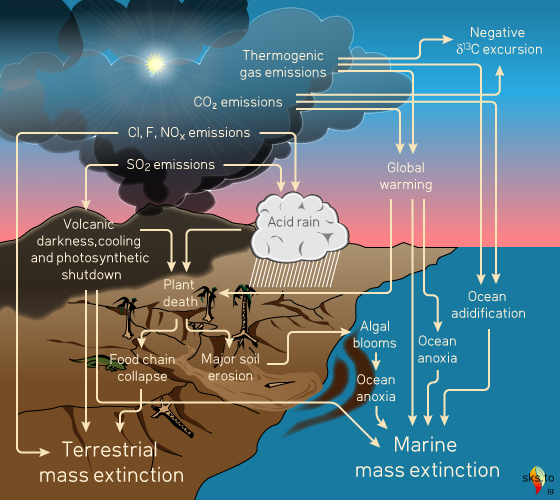
Fig. 6: Clobbered from all sides - the many kill-mechanisms at work in the end-Permian environmental disaster. Graphic: jg.
We may not be able to travel back in time to see what actually happened at the end of the Permian, but we continue to gather the evidence. As Gimli famously remarks in the second part of Lord of the Rings, "No sign of our quarry, but what bare rock can tell!" Today, the rocks are giving up more and more information about past conditions with each passing decade. In the case of the end-Permian, they point to wild temperature swings, acidic rainfall, dead plant communities, massive soil erosion, toxic, acidified seas (fig.6): in other words, the biosphere was clobbered from all directions, repeatedly.
There seems little doubt about it: a massive volcanic episode like the Siberian Traps, volcanism unlike anything Humanity has witnessed, has the potential to create a massive and multi-faceted pollution event on a global scale, with deadly serious consequences for climate, land and ocean chemistry. Could modern human activities have the same effect?
There are a number of differences between Earth today and in the late Permian: some work in our favour and some not.
Firstly, although the late Permian already had a Hothouse climate with high carbon dioxide levels, it is not the absolute levels of CO2 that matter so much: rather, it is the rate at which they change. The rate of emissions in the end-Permian episode, as witnessed by the carbon isotope-spike at the point of the extinction, exceeded the ability of both oceans and biosphere to absorb them. The result was environmental catastrophe. So even though we're not starting with the same conditions as the late Permian, we can't take too much comfort from that fact.
Secondly, geography: in the late Permian there were no polar ice-caps and continental configuration was quite different with landmasses mostly lumped together in the Pangaea supercontinent. End-Permian sea-level rise would have involved thermal expansion alone: in this case we are at greater risk because there are major ice-caps available to melt.
Thirdly, it is thought that late Permian ocean circulation was sluggish, making it easier for anoxic conditions to develop than is the case now with our generally well-mixed oceans.
Fourthly, the sulphur dioxide released by the Siberian Traps volcanism has no modern anthropogenic equivalent. Our sulphur dioxide emissions peaked at ca. 130 million tonnes a year in the 1980s when treaties were agreed to limit pollution from them and the trend is gradually downwards. Compared to the estimate for the Siberian Traps (6300-7800 billion tonnes), one can see that even a century of human emissions at peak levels would still be orders of magnitude less.
An estimated massive (100,000 billion tonnes) carbon dioxide release is thought to have been responsible for the dramatic carbon isotope-spike accompanying the extinction. Let me make this plain: such a spike cannot be generated without something of a drastic nature happening that involves a lot of carbon. The underground cooking of hydrocarbon-bearing evaporite and coal-bearing rock sequences by hot magma has been convincingly blamed for at least part of the release. So how does it compare to our CO2 emissions of ca. 32.3 billion tonnes a year? The late Permian carbon isotope-spike lasted some 2,100 to 18,800 years. Let's round off the figures to make them easier to see in the mind's eye: 2000 to 20,000 years. On the 2000 year scale, to produce a carbon dioxide burp of this magnitude, 5,000 billion tonnes would need to be emitted per century: on the 20,000 year scale it would take 500 billion tonnes per century. That's the range. Our emissions, if they carry on at the present (2014) rate? 3,230 billion tonnes per century. The conclusion is stark: we are outgassing carbon dioxide at the same (or greater) rate as a Large Igneous Province whose overall effects killed most of life on Earth at the end of the Permian.
Late Permian volcanism and associated mass extinction took place, it is thought, over a maximum of several tens of thousands of years. Our self-inflicted environmental changes, assuming for one dreadful moment that we don't get cracking and do something about them, are occurring over a few centuries. The kill-mechanisms may differ slightly from the end Permian events because of the differences outlined in the paragraphs above, but the most likely cause of any future large-scale extinction is nevertheless clear: prolonged environmental stress caused by widespread pollution. Extinction-level events occur when changes to the environment's physical and chemical properties occur on too widespread and rapid a basis for many species to successfully adapt or migrate. If anyone can think of a better incentive to clean our act up than that, let's hear it.
Part One: Large Igneous Provinces and their global effects
Related: So what did-in the dinosaurs? A murder mystery…
This is not an exhaustive list but the findings in these papers (obtained via Google Scholar) are all incorporated in the above account. The new radiometric dates are the work of Burgess and colleagues. For a good general account of LIPs and their effects, the Bond and Wignall paper is a good place to start.
Benton, M.J. and Newell, A.J. (2014): Impacts of global warming on Permo-Triassic terrestrial ecosystems. Gondwana Research 25, 1308–1337.
Bond, D.P.G. and Wignall, P.B. (2014): Large igneous provinces and mass extinctions: An update. In: Keller, G., and Kerr, A.C., eds., Volcanism, Impacts, and Mass Extinctions: Causes and Effects: Geological Society of America Special Paper 505.
Burgess, S.D., Bowringa, S. and Shenb, S. (2014): High-precision timeline for Earth’s most severe extinction. PNAS, vol. 111, no. 9, 3321.
Burgess, S.D. (2014): High-precision U/Pb geochronology of large igneous provinces and mass extinctions : testing coincidence and causation. Ph. D. thesis, Massachusetts Institute of Technology, Department of Earth, Atmospheric, and Planetary Sciences.
Dobretsov, N.L., Kirdyashkin, A.A., Kirdyashkin, A.G., Vernikovsky, V.A. and Gladkov, I.N. (2008): Modelling of thermochemical plumes and implications for the origin of the Siberian traps. Lithos 100: 66-92.
Grasby, S.E., Sanei, H., and Beauchamp, B. (2011): Catastrophic dispersion of coal fly ash into oceans during the latest Permian extinction: Nature Geoscience, v. 4, p. 104–107.
Hinojosa, J.L., Brown, S.T., Chen Jun, DePaolo, D.J., Paytan, A., Shen Shuzhong and Payne, J.L. (2012): Evidence for end-Permian ocean acidification from calcium isotopes in biogenic apatite: Geology, v. 40, p. 743–746.
Kump, L.R., Pavlov, A. and Arthur, M.A. (2005): Massive release of hydrogen sulfide to the surface ocean and atmosphere during intervals of oceanic anoxia. Geology, v. 33, no. 5. p. 397–400.
Ogden, D.E. and Sleep, N.H. (2012): Explosive eruption of coal and basalt and the end-Permian mass extinction. Proceedings of the National Academy of Sciiences USA 109(1): 59-62.
Retallack, G.J. and Jahren, A.H. (2008): Methane Release from Igneous Intrusion of Coal during Late Permian Extinction Events. The Journal of Geology, volume 116, p. 1–20
Saunders, A. and Reichow, M. (2009): The Siberian Traps and the End-Permian mass extinction: a critical review. Chinese Science Bulletin, vol. 54, no. 1, 20-37.
Schobben, M., Joachimski, M.M., Korn, D., Leda, L. and Korte, K. (2014): Palaeotethys seawater temperature rise and an intensified hydrological cycle following the end-
Permian mass extinction. Gondwana Research, Volume 26, Issue 2, 675-683.
Self, S., Schmidt, A. and Mather, T.J. (2014): Emplacement characteristics, time scales, and volcanic gas release rates of continental flood basalt eruptions on Earth Geological Society of America Special Papers, 505. 319 - 337.
Sephton, M.A., Looy, C.V., Brinkhuis, H., Wignall, P.B., De Leeuw, J.W. and Visscher, H. (2005): Catastrophic soil erosion during the end-Permian biotic crisis: Geology, v. 33, p. 941–944.
Sephton, M.A., Jiao, D., Engel, M.H., Looy, C.V. and Visscher, H. (2015): Terrestrial acidification during the end-Permian biosphere crisis? Geology, v.43, p 159-162.
Sobolev, A.V., Sobolev, S.V., Kuzmin, D.V., Malitch, K.N. and Petrunin, A.g. (2009): Siberian meimechites: origin and relation to flood basalts and kimberlites. Russian Geology and Geophysics 50, 999–1033.
Svensen, H., Planke, S., Polozov, A.G., Schmidbauer, N., Corfu, F., Podladchikov, Y.Y., and Jamtveit, B., 2009, Siberian gas venting and the end-Permian environmental crisis: Earth and Planetary Science Letters, v. 277, p. 490–500.
Posted by John Mason on Thursday, 19 March, 2015
 |
The Skeptical Science website by Skeptical Science is licensed under a Creative Commons Attribution 3.0 Unported License. |